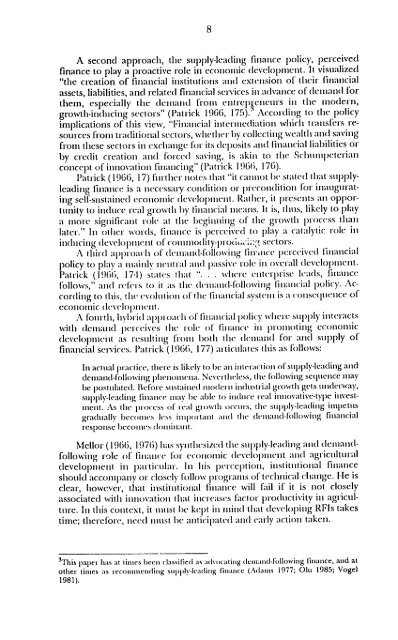I Fiance Apicultural
I Fiance Apicultural
I Fiance Apicultural
You also want an ePaper? Increase the reach of your titles
YUMPU automatically turns print PDFs into web optimized ePapers that Google loves.
8<br />
A second approach, tile supply-leading finance policy, perceived<br />
finance to play a proactive role iii economic development. It visualized<br />
"the creation of financial instititions and extension of' their financial<br />
assets, liabilities, and related financial services in advance of demand for<br />
them, especially the demand from cntrepencurs in the modern,<br />
growth-inducing sectors" (Patrick 1966, 175):' According to the policy<br />
implications of this view, "Financial intermediation which transfers resources<br />
fron traditional sectors, whetlhicr by collecting wealth and saving<br />
from these sectors in exchange for its dleposits anod financial liabilities or<br />
by credit creation and forced saving, is akin to the Schumpetcrian<br />
conce 1)t of innovation financing" (Patrick 19!66, 176).<br />
Patrick (1966, 17) further notes that "it cannot be stated that supplyleading<br />
finance is a ncccssaiy condition or precondition for inaugurating<br />
self-sustained economic developnent. Rather, it presents an opportunity<br />
to induce real growth by linancial means. It is, thus, likely to play<br />
a more significant role at the beginning of the growth process than<br />
lalcr." In other words, finance is perceived to play a catalytic role in<br />
inducing development of coSodit'-lroor,:,:g sectors.<br />
A tlhird alplroach of dl;iad-following fini'tiice perceived financial<br />
policy to play a mainly neutral and passive role in overall development.<br />
Patrick (1961, 171) states that "... where enterprise leads, finance<br />
follows,' and refers to it as the (lciiiand-following financial policy. According<br />
to this, thw evolution of' the financial system is a consequetnce of<br />
A fourth, hybrid alppjroach of financial policy where supply interacts<br />
with demand perceives tile role of finance in promoting economnic<br />
development as resulting from both tile demand for and supply of<br />
financial services. Patrick (1966, 177) articulates this as follows:<br />
In actual practice, there is likely to be an interaction of si pply-leading and<br />
demand-following phenomena. Nevertheless, the following sequence may<br />
be postulated. Before sustained modeln iiindustrial growth gets underw'ay,<br />
SUl)ply-leading fiaince may be able to induce real iIll 1ovat ive-type inivestiuent.<br />
As tle process of leal growti occurs, the SullJly-leading impetus<br />
gradually becomes less impoitalt and the deniand-following financial<br />
lespollse beco Il eS (omllanlt.<br />
Mellor (1966, 1976) has synthesized lie suiply-leading and deniandfollowing<br />
role of filance for economic development and agricultural<br />
development in particular. Il his perception, institutional finance<br />
should accompany or closely follow programs of technical change. He is<br />
clear, however, that institutional finance will fail if it is not closely<br />
associated with iinovatioi that increases factor productivity in agriculture.<br />
In this context, it must be kept in mind that developing RFIs takes<br />
time; therefore, need must be anticipated and carly action taken.<br />
3Fhis paperlIhas at limcs been classi'ie a;ls l vOcating deiclan(-followinlg tfnace, and at<br />
other times as recommending skipply-eadi ng finance (Adamns 1977; Olu 1985; Vogel<br />
1981).

















